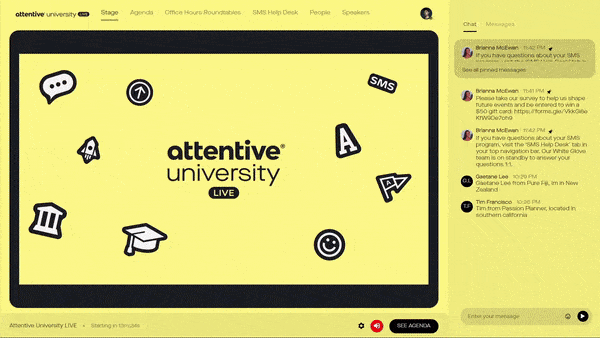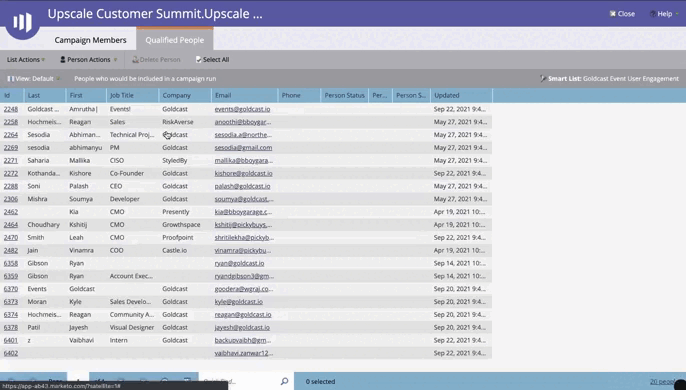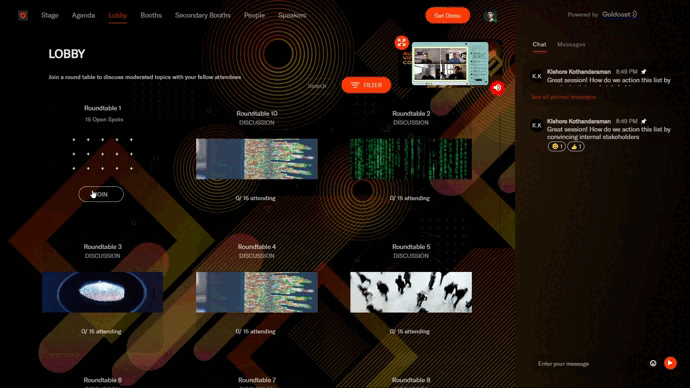What Are the Real Pros and Cons of Virtual Events?

Table of Contents
Maximize Your Marketing ROI
Join 10,000 other marketers already getting the best tips on running engaging events that boost pipeline and create raving fans.
Until recently, virtual events were an under-utilized, under-developed and often underwhelming option for event marketers.
But when the pandemic hit, virtual events were forced to step up to the mark.
In its 2022 Global Meetings and Events Forecast, American Express surveyed 500 event professionals across five continents and 31 countries.
The survey found that 73% of event planners are very optimistic about their ability to use technology to enhance the attendee experience vs. just 61% in 2021. The forecast also revealed that the number of virtual and hybrid event attendees is expected to increase from 2.8% to 3.4% this year.
Clearly, the virtual event experience is here to stay.
But what are the real pros and cons of launching a virtual event? And how do you know if you’ve cracked the recipe?
Today, we’re going to take a hard look at the true benefits and drawbacks inherent in virtual events to help you make the right decision based on your specific goals, needs, and event strategy. Let’s dive in!
Virtual events vs. in-person events: the pros 👍
Virtual events have come a long way.
From one-dimensional webinars to high-engagement multi-track events, there have never been more options for creating a stellar online event experience.
Here are some of the top advantages virtual events can now deliver.
✅ Pro #1: Ultimate accessibility
One major plus for virtual events is the increased accessibility.
Virtual events open you up to a wider audience by removing the barriers to entry typically seen at in-person events.
And that comes with a whole bunch of other benefits, including:
- Lower costs: In-person events can get expensive. The travel, accommodation, time out of office, child care — the list goes on. Virtual events massively reduce these costs. People who couldn’t get the buy-in or budget to attend in-person are suddenly free to join.
- Increased inclusivity: For some, in-person events just aren’t an option. For example, while sign language translators aren’t always available for in-person events, closed-captioning at a virtual event can allow members from the deaf community to actively engage with your content. And for those who are unable to travel, they don’t have to — attendees can stay right where they are and still enjoy every event session.
💡 Tip: Did you know that Goldcast supports live speech-to-text captions? And translated subtitles? Get the scoop on how to make your next event accessible for everyone!
✅ Pro #2: Global reach
In addition to boosting accessibility, virtual events are awesome for increasing your reach. In fact, they can take your brand global at the click of a button. 🌎
And that’s important. Because people aren’t going to travel halfway around the world (or even halfway across the state) for an event they’re not 100% sure about.
“Our business is global, there's only so much you can cater to in-person,” says Eric-Jan (EJ) Schmidt, CMO at worldwide digital marketplace and aerospace business intelligence company ILS. “At our virtual event, we had a fair amount of European attendance and our attendees in Asia could access on-demand. These numbers are very important for us.”
By going virtual, you help minimize attendee risk while boosting attendance. #winwin
“Because people aren’t going to travel halfway around the world (or even halfway across the state) for an event they’re not 100% sure about.”
✅ Pro #3: Maximum scalability
Speaking of expanding your reach, if you’re looking for a way to make your events program ultra scalable, virtual events are a great way to do it.
“We always try to think about how we use our tech stack for good. How do we scale really relevant experiences to our audiences?” says Nina Butler, Sr. Director of Revenue Marketing at B2B gifting platform Alyce.
For Nina and the team at Alyce, events have become the second-highest pipeline creating channel. But in order to get results like that, their ability to deliver a consistently stellar attendee experience at scale was key.
“One of the biggest aspects of scalability is looking at the efficiencies you can glean through the things you're already doing,” Nina explains. And since Nina’s highly successful BDR Gifting Power Hours happen every month, scaling these high-ROI virtual events was a no-brainer.
“Through Goldcast, there's a clone button where I'm like, boop, all right, there's my August event. That ability just to replicate and go is huge for companies that are looking to scale their event marketing programs beyond just the singular event a month.”

With the right virtual event platform, the ability to not just copy/paste but copy/customize your existing events can save event marketers a ton of time, without cutting corners on attendee experience.
✅ Pro #4: Less on-the-day pressure
Let’s face it, in-person events can be S-T-R-E-S-S-F-U-L.
There’s a lot going on. And it’s all happening at once.
But with virtual events, you can balance and redistribute that pressure by taking much of the workload off your plate pre-event.
For brands like translation technology and language services company Smartling, that was a pretty big deal.
“Basically, you can pre-record the entire show, load it into the platform, and then at the time slot when the session is set to begin, it automatically plays the content,” explains Smartling’s Head of Marketing, Adrian Cohn.
With a healthy mix of live and pre-recorded content, virtual events ensure there’s always a backup plan in place.
✅ Pro #5: Better data
As an event marketer you have to constantly prove your worth.
And defining success in field marketing is all about having the right data to track your event key performance indicators (KPIs). But tracking attendee-level data manually at an in-person event can be a major headache.

On the flip side, virtual events let you seamlessly track, measure, and utilize every attendee touch-point, including:
- Registrations
- Attendance
- Time spent in breakout rooms
- Sessions selected
- Content downloaded
- Polls answered (and how they answered)
- Questions asked (and what they were)
- Number of chat messages sent and received
- And more!
The more insights you have on each and every attendee, the more specific and need-meeting your event follow-ups become, and the easier it is to measure the event’s true pipeline impact.
💡 Tip: Did someone say data? Dig into our dashboards to learn more about how Goldcast helps revenue-driven marketers measure event success.
✅ Pro #6: Increased ROI
This one’s no surprise. Virtual events are much more affordable to execute.
Here are just five reasons why:
- Reduced staffing time
- Zero venue expenses
- No catering cost
- No printed branding requirements
- Reduced speaker and entertainment fees due to no travel
By decreasing your event budget, virtual events will help improve the overall ROI of your event program, help you secure buy-in for future events, and make the real cost benefits of virtual events crystal clear to your sales and leadership teams.
✅ Pro #7: Greater attendee choice
Today’s event attendees have come to expect options above all else.
Virtual, in-person, hybrid…there’s no longer just one way to attend an event.
But attendee demands for a buffet of event options doesn’t end at the event format itself. You also need to provide plenty of programming and content options within your event.
Unlike in-person events, virtual attendees don’t have to stand in the hallway and choose between two unmissable sessions. At a virtual event, they have access to everything. 🙌🏻
If they miss one session, they can always catch it later on-demand.
And as a major bonus, you can use your event data to send out relevant and personalized content your attendees actually want to receive after the event.
“Unlike in-person events, virtual attendees don’t have to stand in the hallway and choose between two unmissable sessions.”
✅ Pro #8: Better sales opportunities 🚀
At an in-person event, it can be tough to connect with the key contacts and accounts you want to reach.
Spot them on the way into a session and by the time the networking break rolls around, suddenly they’re gone.

But with plenty of engagement opportunities, and deep integrations with your CRM, a virtual event can help you and your team stay up-to-date on who’s at the event, exactly how they’re engaging, and what specific questions they might need help with.From there, you can use 1:1 messaging capabilities to reach out directly or set up virtual booths for quick drop-in sessions with the sales or customer support team.
✅ Pro #9: Evergreen content for evergreen results
Virtual events are excellent field marketing levers, but they’re also great for content marketing too.
Whether it’s creating:
- Your own on-demand web-channel
- A downloadable resource center
- Or an email campaign with engaging session soundbites
…your event content can be used and reused as many times as you like, with little extra cost or effort.
💡 Tip: Not sure what to do with your event content after the cameras stop rolling? We’ve got you covered. Check out this free guide on how to leverage your content before, during, and after your event.
Virtual events vs. in-person events: the cons 👎
Clearly, virtual events have some strong advantages.
But it can’t all be hunky dory.
Everything has its drawbacks and — especially when compared apples-to-apples with in-person or hybrid — virtual events have their disadvantages too.
The good news is, with the right approach, most of the “cons” of virtual events can be flipped into something positive for event marketers.
Let’s take a closer look at what the drawbacks are and how to flip the script to help reduce any potential downside at your next virtual event.
❌ Con #1: Fewer on-the-spot networking opportunities
Nothing beats the feeling of a firm handshake followed by a great conversation.
And while virtual events will never be able to fully replace the impromptu networking opportunities that seem to happen by magic at in-person events, the good news is — they can come pretty close.
For example, private booths, drop-in/drop-out rooms, session chats, P2P messaging, video calling and other engagement features can help recreate that feeling of freedom and curiosity that comes with being at an in-person event.
❌ Con #2: Not enough ‘wow’ factor
Many event marketers seem to believe that virtual events just aren’t as fun as in-person events. They lack the energy, the vibe, the atmosphere — the wow-factor.
Of course, if your annual gala features a custom fireworks display at the end of night two, it’s going to be tough to recreate that same sense of awe in a virtual setting.
But if done right, your virtual event can definitely capture (and keep!) your attendees’ attention.

Think: Polls, live video Q&As, interactive chat, breakout rooms, and more.
❌ Con #3: Higher risk of no-shows
There’s no way to sugarcoat it. The average no-show rate for virtual events is higher than in-person at 35%.
This is an especially serious risk for free virtual events, where the attendee loses nothing by skipping out.Although losing attendees is never fun, the good news is there are plenty of ways to combat attendee dropoff using your virtual event platform.
For example, automated calendar invites to registrants help make sure everyone has a proper heads-up before the event.
You can even go the extra mile to create customizable email workflows to update registrants on exciting additions to the event agenda and remind them at various intervals of exactly why yours is a must-attend event.

❌ Con #4: Tech failures = game over
We’ve all been there: the glitchy connection, the wifi fail, the muted mic mishaps.
Like any event, tech challenges at a virtual event can be a little… awkward. But unlike any other event, if those tech fails last a significant length of time, they can end up costing you your audience.
Despite the fact that the entire event is running on tech, virtual events often have an added layer of security built-in because you can fall back on pre-recorded content and don’t have to awkwardly stare at a slide deck while the speaker adjusts their mic.
💡 Tip: Concerned about day-of technical hiccups? We get it! Luckily, Goldcast offers hands-on customer support before, during, and after events. Learn more about why we invest in customer success.
❌ Con #5: Limited sponsorship revenue
If you’re spending money on an event and you don’t want to pass the entire cost onto your attendees, onboarding an exclusive lineup of partners and sponsors can be a great strategy.
Whether you set your partners up with a booth, breakout, or keynote, people will pay good money to get access to your in-person audience.
Luckily, going virtual doesn’t mean a complete end to sponsorship sales.
However, it does mean you’ll have to get more creative with your partner offers by:
- Providing relevant advertising, branding, and promotional opportunities.
- Setting up virtual booths that feel organic, never sales-y.
- Providing sponsors with relevant data for personalized attendee follow-up.
❌ Con #6: A battle for attendee attention
These days, sitting behind a screen is hard work.
Attention spans are getting shorter by the second and if you fail to keep your virtual attendees engaged, all they’ve got to do is hit ‘x’ and they’re gone.
But if you have the right virtual event content and the right platform to showcase it, you can give attendees the break they deserve and wow them at the same time — just like the team at Gremlin did.

“We used the booth feature for our networking rooms. One was playing a cartoon marathon, so when an attendee inevitably wanted to zone out for a while they could just hop over there,” explains Karli Williamson, former Senior Events Manager at the chaos engineering platform.
So, is a virtual event effective? It all depends on your approach.
If you play them right, there are way more pros than cons with virtual events.
But if you’re still not sure whether a virtual event is right for you, don’t worry. The options for event marketers are better than ever.
With the imminent return of in-person events and hybrid events slated to be the next big thing in the event marketing world, you can roll up all the advantages of virtual events and pop them right alongside those of your classic in-person strategies.
No matter how you choose to play it, focus on providing an unforgettable experience for your attendees, and trust that the benefits will far outweigh any potential drawbacks.

Transform Your Video Marketing with AI
Stay In Touch
Platform
Resources
© 2026 Copyright Goldcast, Inc. All rights reserved.





 Upcoming Events
Upcoming Events Event Series
Event Series On-Demand Events
On-Demand Events

